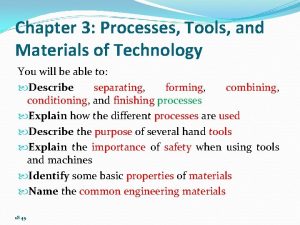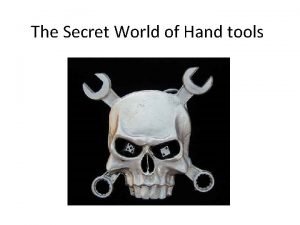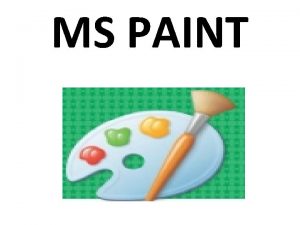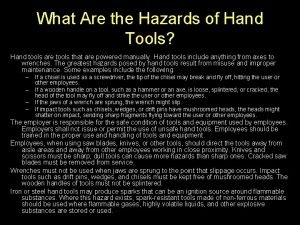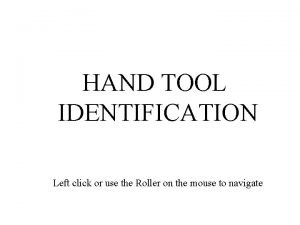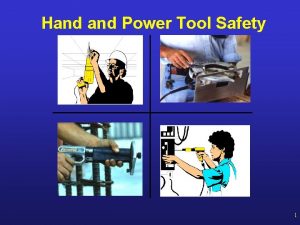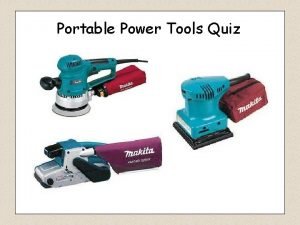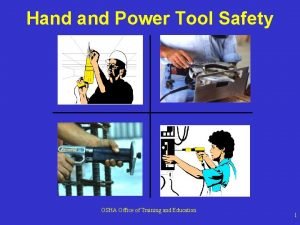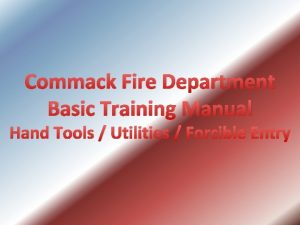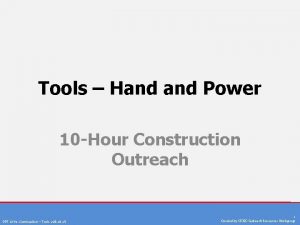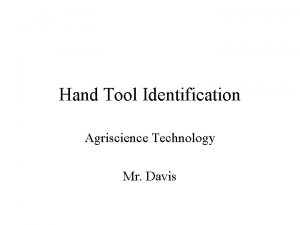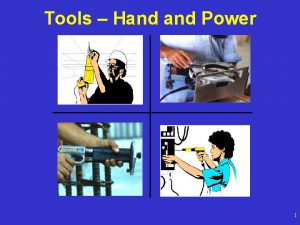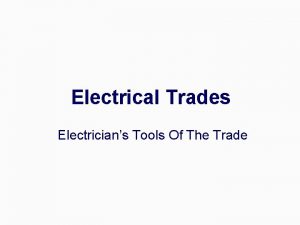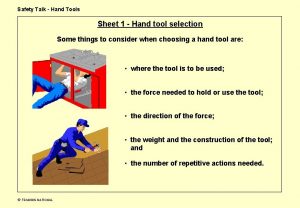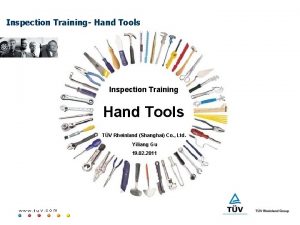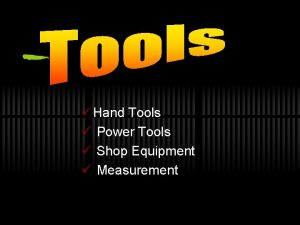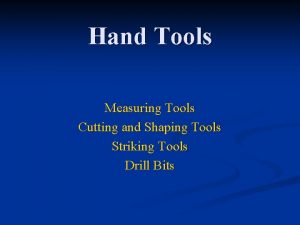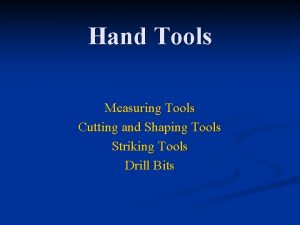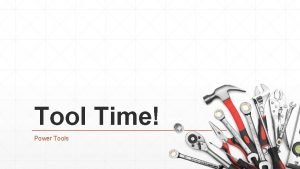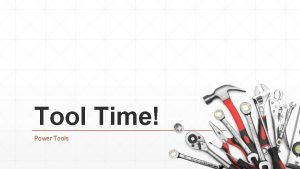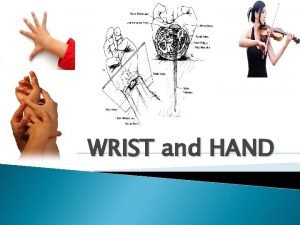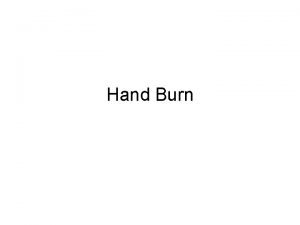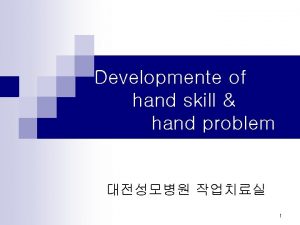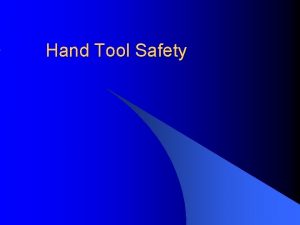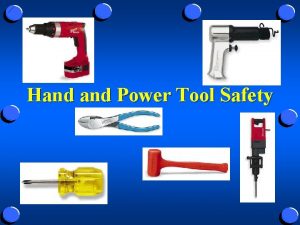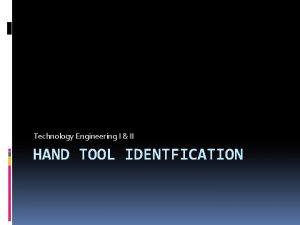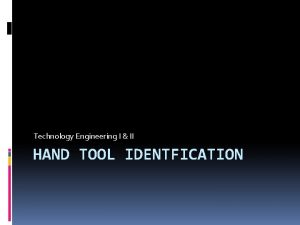The Secret World of Hand tools Hand Tool























- Slides: 23

The Secret World of Hand tools

Hand Tool Safety • Select the right tool for the job • Check tools before use to ensure they have not been damaged • Do not use tool which may cause a spark when working with flammable materials • Do not throw tools to another worker or on to a finished surface • Do not carry tools in your hand when climbing up or down a ladder

Continued • Return tools to their proper place when not in use • Wipe off the tools with a shop rag when you are finished with them (before they go away) • Store sharp edged tools separate from others • Never carry tools in your pocket. Use a tool belt or tool box

Socket Wrenches • A socket is a cylinder shaped, box-end tool for removing or installing bolts and nuts. • One end fits over the fastener. The other end has a square hole that fits on a handle used for turning. • Sockets come in different lengths Standard, and deep-well.

Socket Drive sizes • A socket’s drive size is the size of the square opening for the handle. • Sockets come in four drive sizes ¼”, 3/8” , ½” , ¾” • If too small of a drive size is used on very large or tight fasteners, the socket or handle can be broken. • Too large of a drive may be too awkward for small nuts and bolt heads.

Socket Points • The most common point sockets are: 6 point, 12 point • Points are configurations of the box for the bolt head. • 6 point are used if a bolt head or nut has rounded corners or excessive resistance to turn. • 12 point are used to turn a bolt or nut in tight spots.

Socket Handles • Socket handles fit into the square opening in the top of the socket. • A ratchet is the most commonly used and versatile socket handle. • It has a small lever that can be moved for either loosening or tightening bolts.

Extensions • Extensions are used between a socket and its handle. • They allow the handle to be placed farther from the work piece, giving you room to swing the handle and turn the fastener.

Wrenches • Wrenches are used to install and remove nuts and bolts. • Wrench size is determined by measuring across the wrench jaw. • Wrenches come in both metric (mm)and imperial (inch) • The size is stamped on the side of the wrench

Wrench Rules • Always select the right size wrench. It must fit snugly. • Never hammer on a wrench to break a bolt loose, use a longer wrench. • When possible, pull on the wrench, if it slips you are less likely to hurt your hand. • Never use a steel bar or pipe to increase the length of a wrench for leverage.

#1 Combination box end wrench (one size) #4 Box end wrench used to re/re fasteners to Different sizes (This one has a 10 deg. Offset) #2 Combination open end with ratcheting Box end #5 Crowfoot wrench used with a ratchet for accessing tight places #3 Open end wrench Used to re/re fasteners Two different sizes on The wrench #6 Flare nut wrench used for brake line fittings

#7 adjustable wrench accommodates standard or metric fasteners #10 locking pliers (vise grips) Used for gripping round stock only #11 Locking pliers used for fabricating and Welding to hold material #8 Utility pliers not to be used In place of a wrench #12 Diagonal side cutters Used for electrical work Cotter pin re/re #9 adjustable or slip jaw pliers Sometimes called water pump pliers #13 Needle nose used for electrical and detail work

#14 Flat blade screw driver Used for adjustments or re/re screws #17 Robertson screwdriver used in wood /electrical applications #15 Philips head used to re/re screws #16 Torx bit designed for internal type TORX® fasteners used in the automotive and appliance industries. #18 Nut driver used to re/re fasteners that are hand tightened

#19 Punch, Pin used for complete the removal of roll pins #21 Starter Punch used to initiate the removal and installation of roll pins #20 Punch, Center used to mark metal surface prior to drilling #22 Flat chisel used for cutting bolt heads also used as a wedge

#23 Hammer, Ball Peen, 12 oz. General hammer use #26 Universal joint Friction Ball used when the direct angle of a socket is not possible uses regular sockets #24 Hammer, Plastic Tip, 24 oz used in the disassembly and assembly of trans. Eng. parts. #27 Deep 6 point socket used for re/re nuts & bolts has a better grip designed for long threaded fasteners #25 Hammer, Dead Blow, Ball Peen, 40 oz. delivering a more powerful blow and dampening vibration.

#28 Shallow 6 &12 point socket used with a ratchet to re/re fasteners #29 Impact, Shallow, Swivel or flex socket used when a direct angle is not possible #30 Impact shallow used with pneumatic power tools only for re/re fasteners #31 Socket, Drain Plug, 1/2" male square used for removing service plugs #32 Socket, Double Square, 3/8", 8 -Point used for removing service plugs #33 Adaptor, 3/8" Internal drive x 1/2" external drive used for adapting different drive sockets

#35 Sliding T-Handle, 12“ used for leverage when the handle is slide to the end #36 Breaker Bar (Johnson Bar) Used for mechanical advantage when removing tighten fasteners #37 Ratchet, Sealed Head (High Strength), Standard Handle used in conjunction with sockets to re/re fasteners #38 Speed handle used with a socket for fast removal of fasteners only #34 Extension, 5“ there are different lengths for various applications

#39 Gauge, Torque Angle, 3/8" drive Measures Angle of Rotation - Takes Guesswork Out Of Tightening - Easy Read Numbers Indicate Number Of Degrees Fastener Is Turned #41 Torque Wrench, Click Type, 3/8" drive used to apply a specific torque to a fastener such as a nut or bolt. It is usually in the form of a socket wrench with special internal mechanisms. A torque wrench is used where the tightness of screws and bolts is crucial. It allows the operator to measure the torque applied to the fastener so it can be matched to the specifications for a particular application. This permits proper tension and loading of all parts. #40 Torque Extensions sticks They have a certain elasticity and flex that allows them to flex in sync with the blows of the Impact wrench once a certain amount of torque is reached. The flexing at its torque limit prevents the stick from exerting any more force on the nut and over tightening it.

Beam type torque wrench The simplest form of torque wrench consists of a long lever arm between the handle and the wrench head, made of a material which bends elastically in response to applied torque. A second, smaller bar with integral mechanical indicator is also connected to the head; this is never subjected to torque and thus maintains a constant position with respect to the head. When no torque is applied to the lever arm the indicator rests parallel to the lever arm. A calibrated scale is fitted to the handle so that applied torque, and the associated bending of the main lever, causes the scale to move under the indicator. When the desired torque is reached (as shown by the indicator), the operator stops applying force. This type of wrench is simple, inherently accurate, and inexpensive. developed in the late 1920 s/early 1930 s by Chrysler Corporation

#42 Striking pry bar used for prying, lifting or bending items away from each other #43 Valve lapping tool is used to check the location of the valve- toseat contact area and to smooth the mating surface #44 Valve spring compressors used to re/re engine valves there are different styles on engine and off engine

#45 Valve Tappet Feeler used to set solid lifter & rocker arm clearance #47 Hack saw used for cutting metal #48 Scraper striking used for removing gasket material or dirt from a (metal surface only ) #46 Feeler gauge used for measuring small spaces such as deck warp and gaps #49 Pry Bar used for aligning holes or removing seals

#1 Air Hammer, Heavy Duty #2 Ratchet, Air, Heavy Duty, 1/2" Drive (550 ft. lb. ) #3 Cut off Tool #4 Grinder Air #5 Blow gun #6 Die Grinder

#7 Drill, Air, Reversible. Heavy Duty, 1/2" capacity #8 Impact Wrench, Air, Heavy Duty, 1/2" Drive #9 Sander, Air, Heavy-Duty, Angle, 7" Pad/Disc
 Tools equipment and processes
Tools equipment and processes World of hand tools
World of hand tools Potter's tool is data cleaning tool
Potter's tool is data cleaning tool Image of pencil tool in paint
Image of pencil tool in paint The appropriate cutting tool used in cutting fabrics
The appropriate cutting tool used in cutting fabrics Hazards of hand tools
Hazards of hand tools Hand tool identification
Hand tool identification Hand safety toolbox talk
Hand safety toolbox talk Osha hand tools
Osha hand tools Hand tool dexterity test
Hand tool dexterity test Bennett hand tool dexterity test
Bennett hand tool dexterity test Hand tool safety quiz
Hand tool safety quiz Joint commission tst hand hygiene
Joint commission tst hand hygiene Identify and classify the following carpentry tools
Identify and classify the following carpentry tools Osha hand and power tool safety
Osha hand and power tool safety Floral shears definition
Floral shears definition Manual hand forcible entry tool
Manual hand forcible entry tool Osha hand and power tools powerpoint
Osha hand and power tools powerpoint Hand tool identification
Hand tool identification Hand tool hazards
Hand tool hazards Metalworking hand tool
Metalworking hand tool Hình ảnh bộ gõ cơ thể búng tay
Hình ảnh bộ gõ cơ thể búng tay Frameset trong html5
Frameset trong html5 Bổ thể
Bổ thể
